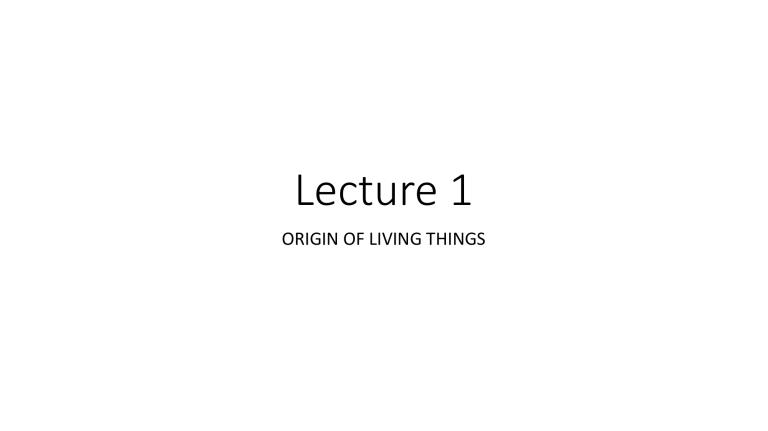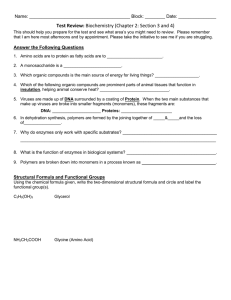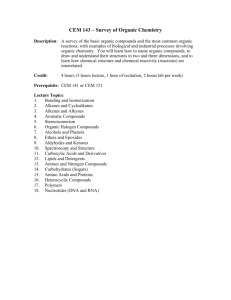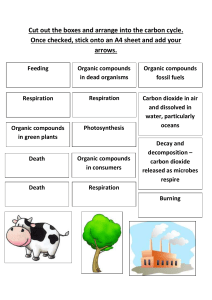
Lecture 1 ORIGIN OF LIVING THINGS THE SCIENCE OF BIOLOGY • Science is an organised body of knowledge which uses a systematic approach of study. In other words, science is the systematic study of natural things around us/phenomena in our environment. • This systematic approach is called scientific method. • Biology is the study of living things The Nature of Science • Science is a path to gaining knowledge about the natural world. The study of science also includes the body of knowledge that has been collected through scientific inquiry. • To conduct a scientific investigation, scientists ask testable questions. To answer those questions, they make systematic observations and carefully collect relevant evidence. Then they use logical reasoning and some imagination to develop hypotheses and explanations. Finally, scientists design and conduct experiments based on their hypotheses. Scientific Method • It is a systematic approach to investigating inquiries that arise from an observed natural phenomenon. Scientists use data and evidence gathered from observations, experience, or experiments to answer their questions. • But scientific inquiry rarely proceeds in the same sequence of steps outlined by the scientific method. ORIGIN OF LIFE • It has been assumed that life has been originated about 5-6 billion years ago. • Two hypotheses has been proposed for the origin of Earth: • 1. Planetesimal hypothesis: • It proposes that origin of earth took place as a part broken off from the molten mass of sun. • 2. Nebular hypothesis: • It is most commonly accepted hypothesis of origin of earth. • It proposes that the earth is originated by gradual condensation of interstellar dust or cosmic dust termed as nebula. • About 10000-20000 million years ago, a highly condensed mass of cosmic material was present termed as ylem that included of neutron, proton, and electron like particles. • The explosion of cosmic material led to numerous pieces called nebula. • This explosion of cosmic material was termed as big-bang, so called big bang theory. • According to nebular hypothesis in the beginning, it was a spinning ball of hot gases and vapours of elements. • However, because of the gradual cooling, the condensation of gases into solid form and stratification according to their density occured. • The elements such as heavy metals Nickel, Iron, Zinc, etc, went to the centre to form the core. • Lighter elements as aluminium, silicon, sulphur etc, constituted mantle and crust of earth. • The lightest and gaseous substances like hydrogen, helium, carbon, nitrogen, oxygen, formed atmosphere. Theories of origin of life Various theories are proposed by various biologists in several period, some of the important theories are listed as below: 1. Theory of special creation: • This theory states that entire universe was formed by super natural power, god. • It was proposed by Hebrew et. al. and was largely supported by Father Suarez. • God created the entire universe in six days, according to Christianity. The earth and the heaven were created on the first day, sky on second day, land and plants were formed on third day, the sun, the moon and the stars on fourth day, fish and fowls on the fifth day and animals including human beings on the sixth day. • Adam was the first man and the first woman was Eve. • God Brahma created life in a single stroke, according to Hindu mythology. • The first man was Manu and Shradha was the first woman. • Due to lack of scientific explanations, this theory was rejected. 2. Theory of spontaneous Generation (Abiogenesis): •This theory proposes that the living form arose spontaneously from non-living materials such as dung, mud, earth etc. • VonHelmont proposed this theory and was supported by Anaximenes and Aristotle. •According to this theory, the origin of insects took place from dew, frogs and toads from muddy bottom of ponds, maggots from decaying meat, tapeworms from excreta of animals and micro-organisms from air or water. •However, Francisco Redi (1668), Louis Pasteur (1864) and Spallanzani (1765) rejected the abiogenesis concept experimentally. 3. Biogenesis theory: • It proposed that life arises from pre-existing life only. • This concept is supported by following experiments. i) Redi’s Experiments: • • • • • Francisco Redi(1668), an Italian physician, placed a piece of boiled meat in each of three separate jars. One jar was covered with parchment paper, the other was covered with muslin cloth, and one was left open. He found that only in an opened jar maggots grew. Only in the opened jar the flies joined and laid eggs that had grown into maggots. Redi concluded, on the basis of the aforementioned experiment, that life can only derive from pre-existing life, not from non-living substances. ii) Spallanzani’s experiments: • • • • In eight bottles, Lazaro Spallanzani (Italy) put hay infusion and then it was boiled to make them sterile. He kept four bottles airtight and four of them loosely corked. After few days, dense growth of micro-organisms was found in loosely corked bottles whereas no organisms were found to develop in airtight bottles. It was concluded that air consisted of micro-organism and was the source of contamination. iii) Pasteur’s Experiments: • In 1864, an experiment was performed by French biochemist Louis Pasteur in favour of ideal of biogenesis. • He used a flask whose neck was bent in form of ‘S’ via heat and filled nearly half of the flask with nutrient solution. • Then it was boiled for several hours to kill all the micro-organisms. • He sealed the tube and left the apparatus undisturbed for various days. • No sign of life was seen in flask. • However, when the neck of the flask was broken, micro-organisms appeared. • Hence, Louis Pasteur concluded that the life can arise only from pre-existing life. 4. Cosmozoic theory: • This theory states that life, in the form of spores or seeds called panspermia, originated from some other planet on earth. • Richter(1865) suggested this idea and Arrhenius supported it. • But this hypothesis is unable to understand why panspermia, including high temperatures and many harmful radiations, could survive in adverse conditions on earth at that time. 5. Modern or Chemosynthetic Theory of Origin of life (Scientific hypothesis): • Scientists now accept that it is not possible to create life spontaneously. • Specific requirements for life’s appearance are essential. • T.H. Huxley and John Tyndall asserted that inorganic chemicals could produce life. • But as the knowledge of biochemistry was not available that time, their ideas were vagued. • This idea was proposed by the Russian biochemist A.I. Oparin(1923) and with J.B.S. Haldane’s assistance. • In his book “The Origin of Life on Earth” in1936, they offered an extensive description of the origin of life by evolution or chemicals. • It is, thus, often called the Oparin and Haldane theory. • According to this theory, through a series of chemical reactions around 4.2 billion years ago, life emerged in water on primitive earth from chemicals, thus called the biochemical theory of origin of life. • It is often referred to as the modern synthetic theory of origin of life. • In three main stages, this theory can be described: Chemogeny, Biogenesis, and Cognogeny. i. Chemogeny: • It includes the creation of complex organic molecules from basic chemicals, such as polysaccharides, fats, polypeptides, nucleic acids, etc. • The different chemogenic phases are as follows: a. Primitive atmosphere formation: • The earth’s primitive atmosphere was composed of elements such as N, H, O, C, etc. • Earth was a fiery spinning ball of hot gases at that time and produced dicarbon, cynogen, metal carbide, etc. • Oxygen was not present in the free state, but as oxides of aluminium, boron, hydrogen, etc. b. Formation of inorganic compounds: • The chemical evolution was favoured when the temperature of the primitive earth fell below. • The most common were atoms of hydrogen. • They associated with all available oxygen to form water. • They all combined with nitrogen and carbon atoms to form ammonia and methane respectively. • 2H + O → H2O (water) • 3H+ N → NH3 (ammonia) • 4H + C → CH4 (methane) c. Formation of simple organic compound: • As the earth cooled down it established a solid crust, which later formed depressions and elevations. • Meanwhile, the vapours of atmospheric water accumulated and eventually arrived as rain on the surface of the earth. • In the depressions, the water that accumulated dissolved the minerals and eventually found the large sized bodies of water called oceans. • If the earth’s surface cools to 50oC-60oC, the inorganic molecules combine to form simple organic compounds such as acetylene, ethylene, ethane, methane, etc. in different forms. • CH+CH→ HC=CH (Acetylene) • CH2+CH2 → H2C=CH2 (ethylene) • CH2 + CH2 → C + CH4 (methane) d. Formation of Complex Organic Compounds • • • • • • e. Formation of carbohydrates, Proteins, and As previously formed, the saturated and unsaturated hydrocarbons mixed and recombined Fat: Eventually, the primitive ocean in different forms to form complex organic compounds such as acetaldehyde, aldol, ethyl polymerized amino acids, sugars, glycerol, acetate, acetic acid, ethyl alcohol, amino acids, and fatty acids, etc., producing massive glycol, etc. through the process of condensation, polymerization, and oxide reduction. macromolecules such as proteins, Condensation reactions: carbohydrates, and fats. • HC≡ CH + H2O → CH3CHO (acetaldehyde) Since these complex compounds are the • CH3CHO + CH3CHO → CH3CHOHCH2CHO key protoplasm constituents of living (aldol) cells, the possibilities for the origin of life Oxidoreduction: in the primitive ocean were established • CH3CHO + H2O → CH3COOH + C2H5OH by their synthesis. Polymerization: In the meantime, the hydrocarbon • CH3COOH + C2H5OH → CH3COOCH3CH2 + H2O reacted to form nitrogen bases, purines • CH2OHCOOH + NH3 → CH2NH2COOH + H2O For the above reactions, the sources of and pyrimidines with the hot water energy were ultraviolet rays, volcanic eruptions, vapour hydrocyanic acid and ammonia. electric energy produced during lightening. The oceanic water becomes a rich blend The complex organic compounds that were formed in ocean gradually got collected in of organic compound called hot dilute primitive ocean. soup or primordial soup or broths by Haldane as a result of the above chemical reaction. ii. Biogeny: • Following Chemogeny, the next step is Biogeny. • Biogeny refers to the formation of primitive life. • Biogeny consists of following events: a. Formation of nucleic acids and nucleoproteins: • Organic compounds reacted and aggregated to create new molecules of greater size and complexity in the primordial water, organic soup. • Nitrogen-bases combined with sugar and phosphate to form nucleotides at high temperatures in primitive soil during chemical reactions. • A large number of nucleotides in various combinations are joined together to form very complex molecules called nucleic acids. • Nucleic acids had tendency to replicate. b. Formation of Coacervates: • Due to intermolecular attraction, the complex organic compounds of primordial soup are collected to form large colloidal cells such as aggregates called coacervates or microsphere. • As they had the power of growth and break, such coacervates were efficient and multiplied. • Coacervates formation is referred to as coacervation. c. Formation of Primary organism: • In approximately 3.8 billion years ago, according to Oparin coacervates, which acquired nucleoproteins either from seawater or by synthesizing themselves, first cellular organisms called eobionts or pre-cell or protobionts were created. • The outer limiting membranes were created by certain fatty acids, having strong affinity ,to water. • For both positive and destructive reactions, some forms of proteins of eobionts started acting as enzymes. • The eobionts were identical to protovirus, a present-day virus. • There were anaerobic and prokaryotic chemo heterotrophs. • iii. Cognogeny: • Diversification of primary species into various modes of life is involved. • a. Origin of autotrophs: • As the number of chemo heterotrophs steadily increased, they absorbed organic nutrients, contributing to a reduction in the ocean’s natural food supplies. • Therefore, primitive organisms began to synthesize organic compounds abundantly present in the sea from inorganic molecules. • The anaerobic breakdown of chemicals due to the absence of chlorophyll has provided the energy needed for the synthesis of organic food. • Therefore, they were chemoautotrophs, such as nitrifying bacteria, sulphur bacteria, iron bacteria, etc. • 6CO2 + 12H2S → C6H12O6 + 6H2O +12S • Later, a green substance from the sea’s magnesium porphyrin called bacteriochlorophyll was formed by some autotrophic prokaryotes and photosynthesis began. • This led to the creation of photoautotrophs, such as today’s marine planktonic bacteria. • As they did not use water to photosynthesize, they were anoxygenic. • 6CO2+ 12H2S → solar energy C6H12O6 + 6H2O + 12 Bacteriochlorophyll • Upto this time, free oxygen was unavailable in the atmosphere. • At that duration, bacteria chlorophyll went through molecular changes to form true chlorophyll and hence, true photoautotrophs were evolved. • These phototrophs synthesized their food by photosynthesis utilizing water as raw material. • Cyanobacteria was the first oxygenic and aerobic photoautotrophs that evolved about 2700 million years ago. • 6CO2+ 6H2O → C6H12O6 + 6O2 • b. Origin of eukaryotes: • • • • True photosynthetic prokaryotes have shifted to aerobic respiration. Then cyano bacteria developed a true nucleus like prokaryotes and transformed into eukaryotes. It were like today’s unicellular species. Multicellular species have evolved from unicellular organisms via the colonization process. Evidences in support of origin of life: Miller-urey experiment • In 1953, Stanley Miller and Harold Urey conducted an experiment to test the biochemical origin of life hypothesis offered by Oparin and Haldane. • Miller- Urey Experiment: • Miller constructed an apparatus of glass tube and flask termed as the spark discharge apparatus. • The apparatus depicted primitive earth conditions, including a reducing atmosphere and an ocean. • A mixture of gases methane, ammonia and hydrogen was maintained in the gas chamber in the ratio 2:2:1 and water in another chamber. • The gas mixture was pumped through the apparatus and the energy was supplied through the use of electrodes in the gas chamber by boiling water and electric sparks. • The experiment initiated with switching on the electric source and boiling the water and is continued for a week. • Observation: • They noticed a condensed liquid with a dark colour. • It was gathered and chromatographically analyzed, and the liquid was found to be a mixture of sugars, amino acids (glycine, analine, etc.) and fatty acids. • Conclusion: • The experimental results support the Oparin-Haldane theory of the origin of life that organic molecules are created from inorganic molecules during the course of the origin of life. Biostatistics central tendency measurement Biostatistics is a branch of biological science which deals with the study and methods of collection, presentation, analysis and interpretation of data of biological research. Biostatistics is also called as biometrics since it involves many measurements and calculations. In Biostatistics, the statistical methods are applied to solve biological problems. Steps in biostatistics A biostatistics investigation is carried out through the following sequential steps. (1). Collection of data (variable) (2). Classification of the collected data (3). Analysis of data (4). Interpretation of data. Application of biostatistics 1. Research Research is incomplete without the Classification of biostatistics statistics Every result (data) in the research need • The biostatistics is conventionally divided into two to be statistically validated. For the design of experiments aspects Selecting the method of collection of • (1). the design of experiments data for getting or collecting data. Deriving logical conclusions from the data • (2). the statistical analysis or Deriving single values from a group of statistical method. variables 2. Medical and Pharmaceutical Science ● For checking efficiency of drugs ● To find out the possible effects of drugs ● For conduction of drug treatment trials. 3. Genetics ● Study the inheritance patterns of genes ● Essential for the study of Mendelian Genetics ● For studying the genetic structure of a population. ● Studying the behaviour of genes in population (Population Genetics) ● For the mapping of chromosomes 4. in numerical taxonomy 5. for monitoring the community and public health 6. Demography (Study of human population) 7. Statistics helps to implement policies by the government 8. Used in weather forecasting Central tendency: Mean, median and mode • Measures of central tendency help you find the middle, or the average, of a data set. The 3 most common measures of central tendency are the mode, median, and mean. • Mode: the most frequent value. • Median: the middle number in an ordered data set. • Mean: the sum of all values divided by the total number of values. • In addition to central tendency, the variability and distribution of your data set is important to understand when performing descriptive statistics. • Distributions and central tendency • A data set is a distribution of n number of scores or values. END OF THE LESSON




